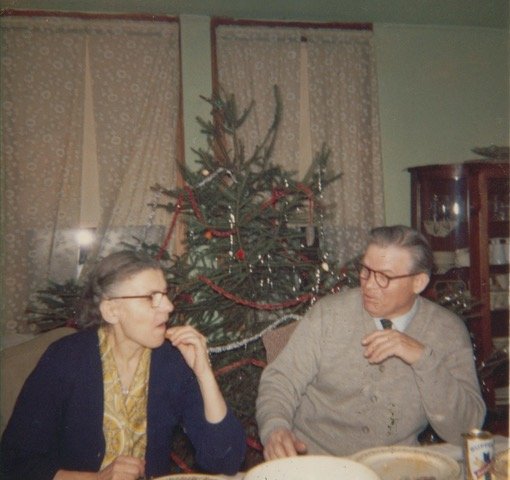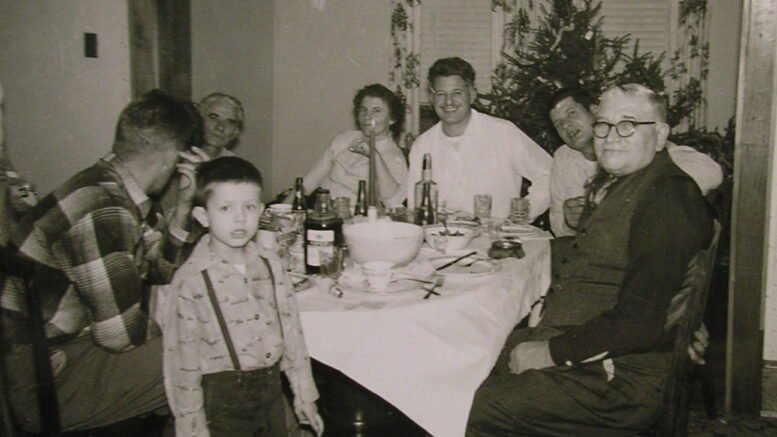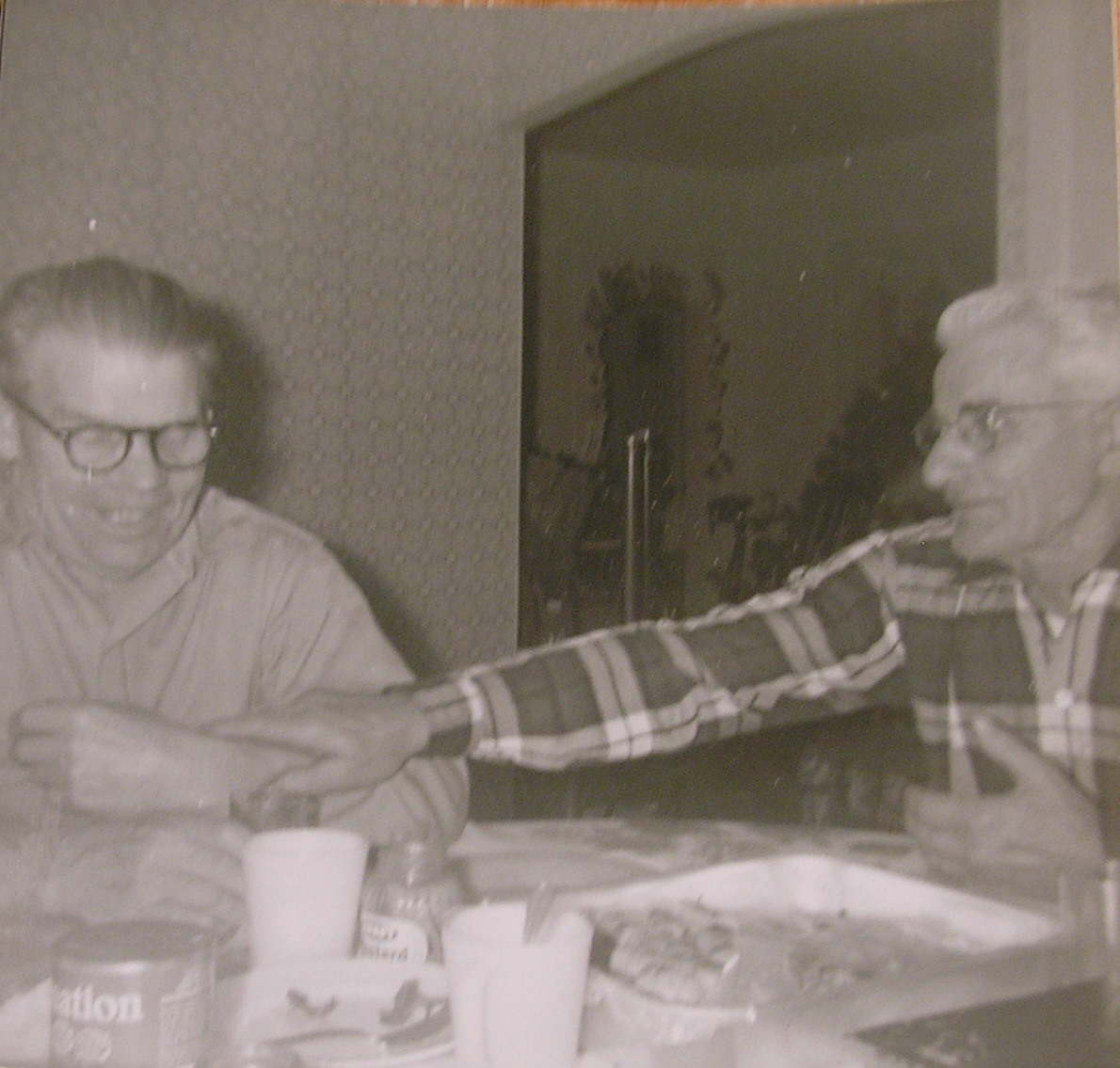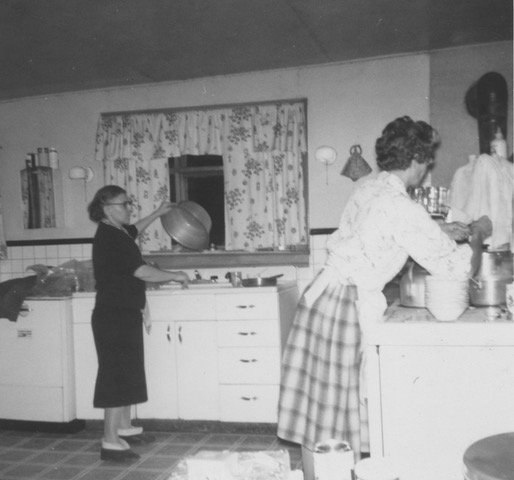Most people have special recollections concerning the Christmas holidays. Mine are associated with a traditional Polish Christmas that was celebrated on my grandfather’s farm from the 1920’s through the 1970’s. The most important component concerned the activities and traditions associated with Christmas Eve, or Wigilia in Polish.
It was important to begin soon after sundown, but later than anticipated barn chores could cause a delay. Since my Polish grandmother died in 1956, my mother and my aunt cooked the food in their respective homes and we brought these things to the farm.

Pictured on Christmas Day in 1958 are Ed Nizalowski, Sr., John Nizalowski, Jennie Kuzia, and Helen Nizalowski. Provided photo.
In the dining room there would be a tree with fairly simple decorations. Occasionally wheat or straw would be placed in the corners of the room. Hay was always placed under the tablecloth.
Fasting was necessary during the day, but the food for Wigilia was especially important. Meat was not allowed. The first course would be mushroom-barley soup. Hopefully the mushrooms were ones that had been picked in the fall and might be a type called popinki, which were especially flavorful.

Pictured in this Christmas Eve photo from 1962, are Eleanora Rafalska and Anthony Nichipor. Provided.
Next would come pickled herring. The two main courses were golombki (cabbage rolls) and pierogi (dumplings). The golabki could have rice or buckwheat filling and the pierogi could have potatoes, sauerkraut or prunes). Fish was not as important to us, but played a much bigger role in many Polish homes. Homemade breads were a special treat, and dessert was a poppy seed roll or kolachki.
When everyone was ready for the meal and at his or her seats, a candle was lit to symbolize Christ being the light of the world. The adults then said Our Father and Hail Mary in Polish. These two prayers have a chanting-hypnotic effect when recited by a group of people. We then had a toast with holiday spirits. Almost every kid got a little something to partake in the toast.

Pictured in the Christmas Eve photo from 1972 are Jennie Kuzia, and John, Jean and Helen Nizalowski. Provided.
Next came the oplatek. Oplatek are square sheets of communion wafer that have religious or holiday scenes embossed on them. The head of the household would go to each person at the table and have them break off a piece. In our case my grandfather would start with my father, who was his oldest son. When this happened you wished each other holiday greetings or perhaps success in future projects or difficult endeavors that might be pending.
It could also be a time of reconciliation for disputes that had erupted over the course of the year. In each case there was a hope that everyone could return once again for the next Wigilia.
My father would make sure that he got a big enough piece that he could go to his wife and then to all his children, and go through the same greetings. If the original piece was not adequate, other pieces could be started. Sometimes we embraced and often kissed each other. This was also customary for the men, which is accepted practice in Polish culture.
We usually received oplatek from our relatives in Poland. This was a special way of remembering them and extending them good wishes even though they could not be physically present. After the meal we got presents from my grandfather and uncle; my grandfather often gave each of us $5 in a small envelope. We got presents from our parents on Christmas day.
As we were sitting around the table munching on treats, my grandfather would often burst into a Polish Christmas carol. He had quite a good voice, but this could be disconcerting until you got used to it. We would sing American carols as well.
As a youngster, I was not aware of the significance or meaning behind many of these traditions. I have since learned more of these matters and learned about many traditions that could be part of a Polish Christmas Eve. Many of these had been carried over from pagan times.
Although the Christian church allowed some of these to stay or had simply given up trying to stop the traditions, it frequently changed the interpretation of the custom. Much of the folklore was centered on Christmas Eve being the shortest or nearly the shortest day of the year. It was a harbinger of lengthening days and thoughts of spring and planting.
There was a traditional belief that spirits were about on Christmas Eve and needed to be appeased. Prophecies might be garnered about the coming year. Actions done correctly would enhance the coming year, or if done incorrectly would lead to difficulties.
It was important to have an even number of guests at the table. An odd number would mean that someone at the table would die during the course of the year. It was also important to start when the first evening star appeared in the sky.
Young girls could pull a straw from underneath the tablecloth to see what kind of man they might marry. If one were free of sin and pure of heart, there was a chance of communicating with the animals in the barn. If my grandfather ever did this, it happened after we left for the evening, but at least one other Eastern European in the neighborhood told me that her father maintained the practice. Leftover oplatek could be fed to the dogs to keep them sane during the next year and a mixture of oplatek and vegetables fed to the cattle would keep the milk plentiful and unspoiled.
With the Eastern European farming culture steadily diminishing, these kinds of traditional celebrations are a thing of the past. We still get together on Christmas Eve to visit with family members, but the religious and traditional significance no longer has the same driving force. We can lament the decline and disappearance of these traditions, but much of it stems from an inevitable process of assimilation and transformation.
I would enjoy experiencing those times again, but I realize that the special historical and cultural forces that produced those times cannot be duplicated. However, I keep thinking of a perception that was stated by a Civil War veteran in the PBS series that was written by Ken Burns. The man somehow felt that somewhere in space and time the Civil War was always being fought. Gallant acts of bravery and heroism continued without stop, and the fallen heroes were carried from the field of battle by warrior maidens that brought them to Valhalla. The heroes would celebrate their actions until they were ready to return to battle and fight alongside the living.
In my own mind I feel the same way about these traditional celebrations. It was a very intense experience that fascinated me when I was young and for which an appreciation has steadily grown. For a few hours in that dimly lit room with winter’s grip fully enveloped for the next several months, I felt transported back to the Old Country. It connected me with the traditions that had been brought by my grandparents; traditions that helped them keep their identity and respect in this new and sometimes hostile country.
As with these Civil War veterans, somewhere in the cosmos the celebrations of these Eastern European peasants continues. As they brought many of these hill farms of Tioga County back to life and feasted at their tables, those of us who experienced those times can feast on these traditions, which they brought from another part of the world and which they passed on to their progeny.
If anyone has ethnic traditions or memories they would like to share, Eastern European or otherwise, feel free to email ed.nizalowski@gmail.com.





what wonderful memories! thank you for sharing the special feeling of Christmas.
While the customs of my ancestors has been lost to me inasmuch as my ancestors came to these shores in the early 1700s, your sharing of the Polish traditions relating to Christmas eve takes me back to the 1970s when I served a church where our custodian was Polish and shared with me his traditions which match yours. Thanks for reminding me of my custodian, a man I learned to appreciate very much. Rich Barron